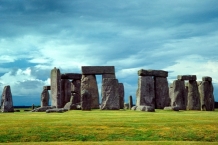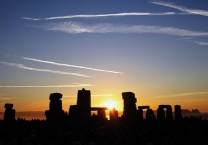Stonehenge
Worth visiting
Added on 09 Mar 2017,
last edited by biroto-Redaktion on 09 Mar 2017
Nearby cycle routes and tours
| Route name | Type | Dist. to route |
|---|---|---|
Route | 1,8 km | |
Tour | 2,2 km |
![]()
Please wait - map data are loading
Type of sights
Archaeological site
Name and address
Stonehenge
GB-SP4 7DE Amesbury
GEO-data
Geodetic coordinates
51.17∎∎∎∎ -1.82∎∎∎∎
Elevation
104 m
Communication
Information about copyright | |
|---|---|
Rights owner | |
Rights characteristic / license | by-sa: CREATIVE COMMONS Attribution-ShareAlike |
Link to the description of the license | |
Image taken over from | |
Image has been uploaded | by biroto-Redaktion on 09 Mar 2017
|
Information about copyright | |
|---|---|
Rights owner | |
Rights characteristic / license | by-sa: CREATIVE COMMONS Attribution-ShareAlike |
Link to the description of the license | |
Image taken over from | https://commons.wikimedia.org/wiki/File:Summer_Solstice_Sunrise_over_Stonehenge_2005.jpg |
Image has been uploaded | by biroto-Redaktion on 09 Mar 2017
|
Stonehenge is a well-known Neolithic and Bronze Age stone monument located in a UNESCO World Heritage Site (WHS) on Salisbury Plain in Wiltshire, England. The whole WHS is quite large and contains many other structures from the Neolithic and Bronze Ages.
Understand
Stonehenge is in a World Heritage Site of over 2000 hectares that is considered one of the most archaeologically rich in Europe. It is home to some of the most important Neolithic and Bronze Age finds and structures in the UK, and contains some 200 scheduled monuments. It is also the site of one of the biggest Chalk grassland reversion projects in the world.
Stonehenge is owned by the nation and is administered by English Heritage. Much of the World Heritage Site land is owned by local farms, but a third is owned and managed by the National Trust who are spearheading the grass regeneration scheme.
A new visitor facilities is now open, part of a new joint approach by English Heritage with the Salisbury Museum and the Wiltshire Heritage Museum in Devizes ![]() .
.
History
Evidence indicates that the area around Stonehenge has been occupied since around 8000BC, but it was during the Neolithic and Bronze Age periods that the vast majority of the monuments around it came to be built. Early work at Stonehenge itself began in 3000BC when an outer ditch and embankment was constructed, and standing timbers erected. From about 2500BC, Neolithic and Bronze Age man started to bring Bluestones and Sarsen stones from Wales and the Marlborough Downs. It was not until 1600BC that Stonehenge came to be completed. Most of the other monuments in the area such as Durrington Walls and Woodhenge date from the same period. A nearby hill fort was built during the Iron Age, and there is evidence to suggest that the area was extensively settled by the Romans. The nearby town of Amesbury was later settled during the Saxon reign in 979AD.
Stonehenge and the land immediately around it was bought for the nation in 1918. Being on the edge of the military training area Salisbury Plain, a large number of military facilities have also been constructed in the area, including military barracks, a light railway and an aerodrome built within a stone's throw of Stonehenge (most of which has now fortunately been removed). Since then the National Trust has acquired some 850 hectares around Stonehenge, and the area was given UNESCO World Heritage status in 1986.
Landscape
The Stonehenge landscape is one of the best preserved areas of readily accessible chalk downland in the UK. On the edge of Salisbury plain it features several rolling hills and dry river valleys that allow for pleasant walks without too much trouble. Surrounding farmland is ideal for crops and animal grazing.
See
Aside from the plentiful wildlife and nature available, the UNESCO site is considered one of the most impressive archaeological sites in Britain. The landscape boasts several outstanding Neolithic and Bronze Age monuments that can be reached on foot a short distance from the famous Stonehenge [2].
Stonehenge
Unlike the other monuments in the area, there is an entrance charge (but see below). An entry fee of £15.50 for adults and £9.30 for children (Apr 2016) includes an audio guide. Tickets are best purchased on-line before visiting, you need to give a time for your visit but except peak time there is some flexibility once you arrive. There is no access to the stone circle itself - visitors are guided around the monument by roped pathways and on-site attendants. The audio guide is available in several languages and if you listened to all available material would take an estimated 30–60 minutes.
It is not usually possible to walk among the stones themselves, but English Heritage and some tour operators from Salisbury can arrange early morning or evening visits allowing you to do this [3].
If on a budget, you can view the stones for free from the access land ![]() a short distance away on the north side. The access land also contans various tumuli (burial mounds) nearby.
a short distance away on the north side. The access land also contans various tumuli (burial mounds) nearby.
Stonehenge Cursus
A huge and mysterious monument, the cursus is a 3 km long earthwork just north of Stonehenge. Consisting of a ditch and bank running east-west, it is still visible on the landscape, although its purpose remains unknown.
The Avenue
A ceremonial approach way to Stonehenge, the Avenue links the monument to the river Avon. Its ditch and embankment can still be seen from the stones, and its path can be followed up to King Barrows Ridge.
Winterbourne Stoke Barrows
A mile west of Stonehenge is a collection of every type of burial mound found in the UK. A neolithic long barrow creates an alignment that later Bronze Age barrows have been built on, including distinct bowl, bell, pond, saucer and disc barrows.
Normanton Down
Less than half a mile south of Stonehenge, this is a cemetery of over 50 barrows, including the famous Bush Barrow with finds in the Wiltshire Museum
in Devizes
![]() . The area around the barrows is now an RSPB reserve for stone curlews.
. The area around the barrows is now an RSPB reserve for stone curlews.
King Barrows Ridge
So called because of its commanding views of Stonehenge, King Barrows Ridge is on the course of the Avenue, and delivers one of the most breathtaking views over Stonehenge bowl.
Woodhenge
A contemporary monument to Stonehenge, Woodhenge was a series of timbers erected in oval rings, and like Stonehenge is aligned to the rising sun on the summer solstice. The old timber postholes are now marked with small concrete plinths (although there are plans to reconstruct the timbers as they may have looked), and although short on information the site offers a peaceful location away from the crowds at Stonehenge.
Durrington Walls
Just north of Woodhenge, Durrington Walls has been revealed as the site of a great Neolithic village, and likely home of several religious activities. The walls themselves are the remains of the largest henge (earthworks) monument in the UK - some 500 in diameter.
Do
- Take the opportunity to explore the countryside and monuments surrounding Stonehenge instead of just viewing the stones and leaving. The National Trust offer excellent guided tours of the landscape. Contact details are on the [4]. Additionally a great deal of information can be gained from the information boards around the area that isn't available from the Stonehenge centre.
- Visit Stonehenge on the Summer Solstice (21 June), Winter Solstice (21st, 22nd or 23 December), or the Spring and Autumanal Equinox, in order to gain free entry to the stones (and sometimes walk among them), and to venerate nature with the neo-pagans and druids who gather here at these dates.
- Take the opportunity to find out more about Stonehenge at the two nearby museums that have nationally important collections - Wiltshire Museum and Salisbury Museum. See finds from Stonehenge, Woodhenge and Durrington Walls, as well as gold from the time of Stonehenge.
Information about copyright | |
|---|---|
Rights characteristic / license | by-sa: CREATIVE COMMONS Attribution-ShareAlike |
Link to the description of the license | |
Input taken over from: |
Wikivoyage contributors, 'Stonehenge', Wikivoyage, The FREE worldwide travel guide that anyone can edit, 15 February 2017, 12:18 UTC, <https://en.wikivoyage.org/w/index.php?title=Stonehenge&oldid=3150875> [accessed 9 March 2017] |
taken over / edited on | 09 Mar 2017
|
taken over / edited by |
|
Nearby cycle routes and tours
| Route name | Type | Dist. to route |
|---|---|---|
Route | 1,8 km | |
Tour | 2,2 km |
Added on 09 Mar 2017,
last edited by biroto-Redaktion on 09 Mar 2017


